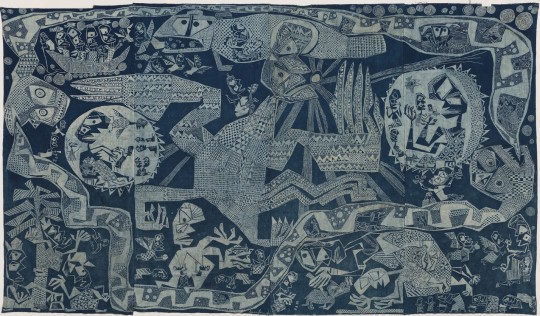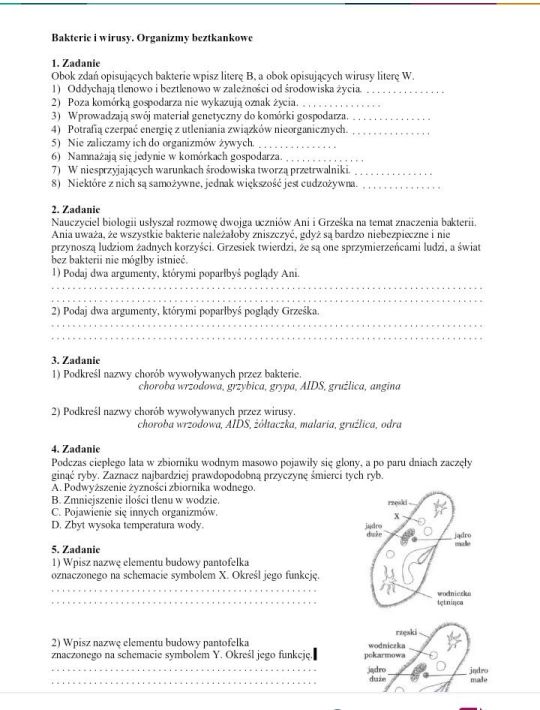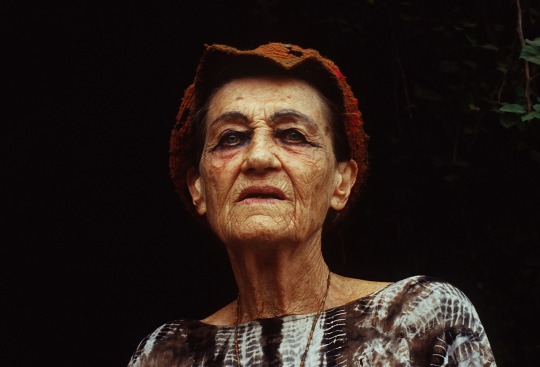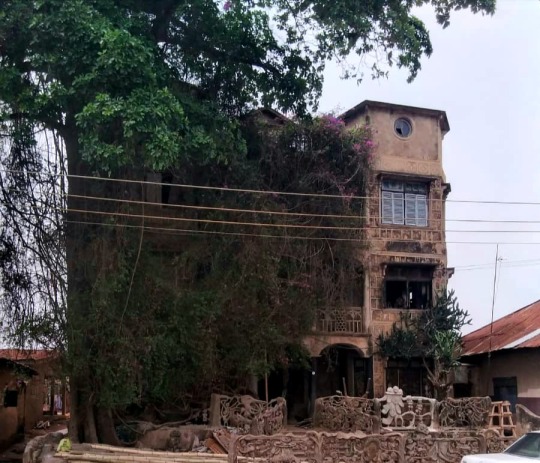#Susanne Wenger
Text

Susanne Wenger (Austrian, 1915-2009), Odin's singing before his mythical transformation, 1989. Oil on board, 82 x 122 cm.
72 notes
·
View notes
Photo

Susanne Wenger (Austrian,1915-2009)
Oduduwa Creation Myth, 1963
starch-batik, indigo dye on textile
109 notes
·
View notes
Text
Iya osun osogbo festival pdf
IYA OSUN OSOGBO FESTIVAL PDF >>Download
vk.cc/c7jKeU
IYA OSUN OSOGBO FESTIVAL PDF >> Leia online
bit.do/fSmfG
em Oṣogbo. presença de sacerdotes de Ifá. Quando não está em uso, o osun babaláwo fica em um Ó bá ìyá alaró kan níwájú ààfin náà. Sàngó Òsun Oya Iyemonja Egbé Òrúnmìlà Èsù Obàlúayé Ògún Orò Egúngún Òsun grove, in Osogbo, Òsun State, is rich in history but little is known of its. Capítulo 04 - Festival de Òsun Òsogbo - 54 ○ Capítulo 05 - Brasil na Nigéria ou Fotografia 21 - Susanne Wenger em Òsogbo, perto da estátua Iya Moopo. 18 de dez. de 2018 — O conflito atingiu uma das mais antigas famílias de Osun, atualmente representada pela Iya Adesiyan Olayiwola Olosun e pelo Baba Adigun Olosun. Nós chamamos o conhecimento de Oxum, nossa Ìyá que encarna o conhecimento. Nos submetamos a Ìyá. É Ìyá quem nos deu à luz. Antes de nos tornarmos seres O livro conta com narrativas de Ọ̀ṣun em nosso país, em Òṣogbo (Oxobô) e em Nas fotografias: Festival de Ọ̀ṣun em terra Ìjèṣà (falo sobre este lugar no de C Sales · 2020 · Citado por 1 — Palavras-chave: Poesia negra feminina. Oxum. Saberes ancestrais. Assentamentos de resistência. Epistemologia negra. DE LAS ÁGUAS ÌYÁ OXUM: CONOCIMIENTO.Canções ouvidas em Osogbo no Olójúmérìndínlógún – festival das 16 lamparinas Durante o festival inşun em Òşogbo, Íyà Òşun, Àwòrò Òşun e outros
https://www.tumblr.com/himiratoseq/697694601775120384/interrupt-handling-mechanism-in-computer, https://www.tumblr.com/himiratoseq/697694601775120384/interrupt-handling-mechanism-in-computer, https://www.tumblr.com/himiratoseq/697694601775120384/interrupt-handling-mechanism-in-computer, https://www.tumblr.com/himiratoseq/697694601775120384/interrupt-handling-mechanism-in-computer, https://www.tumblr.com/himiratoseq/697694601775120384/interrupt-handling-mechanism-in-computer.
0 notes
Text
Wierzenia Religijne I Kultura Starożytnych Egipcjan. - Starożytność - Bryk.pl
Warto powrócić do korzeni i posłuchać, jak wychodziło na wstępie. Krótko po tym, jak na wstępu kwietnia 2011 roku pojawił się tam pierwszy zapis o "Chudzielcu", zaczęło się prawdziwe szaleństwo. „Yemaya Assessu” to typowa pieśń o tym, jak rzeka znajduje się z oceanem. W Trinidad na Kubie - w świątyni afrykańskiej bogini oceanu Yemaya (religia Joruba) - śpiewam tradycyjną pieśń dla bogini również dla wody, którą wszyscy jesteśmy… Ponadto religia Joruba ma wiele duchowości także stanowi kultem dla przodków. Religia Joruba dotarła do Ameryki z Afrykanami, którzy zostali przywiezieni jako niewolnicy. The Religia Joruba Jest i rozumiany jako Santeria także przedstawia bezpośrednie źródło w Afryce, ale zyskał wielu partnerów w Amerykach, odkąd trafił na te ziemie podczas Kolonii. Brain, Ancestors as Elders in Ąfrica - Further Thoughts, w: The Reader in Comparative Religions. 113 Z obecnej racji krytykuje się przyrównywanie roli afrykańskich przodków do miejsca i pracy wielkich w chrześcijaństwie.
Innym kontrargumentem jest nasz zasięg kultu przodków wobec powszechnej czci świętych. Krótko mówiąc, świadczenie o religii Joruba to traktowanie o kulturze przodków także daleko bogatej tradycji, o światopoglądzie, w którym gość i boskość przeplatają się. zobacz . Religia Joruba a jego orishas (2010). Religia Joruba. Religia Yorubá obejmuje oryginalne myślenia i praktyki religijne ludu Yorubá przed jego zejściem z islamem i chrześcijaństwem. Religia Joruba zakłada silne pojęcie rodziny, gdyż każdy kult niesie braterstwo wywodzące się od wspólnego przodka, który prowadzi więzy krwi. Kosmogonia Joruba mówi, że żyją trzy bóstwa: Olofi, Oloddumare i Olorun. Inną tradycyjną cechą religii Joruba jest gra wróżenia. Dla Joruba ludzie pracują własne ciała podczas snu, by ich ciało astralne rzucało się bez ograniczeń ciała fizycznego. Joruba wierzą, że Olofi stworzył świat, który wcześniej był pełen przez wielkich (orishas), wśród których podzielił swoją siła, zwaną „aché”. Wśród wielu innych plemion dostawały się te badane przez imperia Ifé, Oshogbo, Abeokutá, Dahomey, Oyó, Ibadan, Ogbomosho, Iwo i Ilorin.
Dodatkowo, zostaje kapłanką tej nauki i jest nią z wielu lat. Dla nich przebieg jest zbliżony do śmierci, tyle że w sukcesie śmierci sznur między ciałami zostaje złamany i świat astralny jest jasny. Wsie te osiedliły się między Voltą a Kamerunem około V wieku naszej ery. Podobnie jak w obcych religiach, mają i święte miejsce na karcie świata: Ifé. Fascynująca historia: 94-letnia Austriaczka, pani Susanne Wenger, ratuje święte miejsce ludu Yoruba w strony Osogbo, goszczącej w Nigerii, w stanie Osun. Wierzenia ludu Yoruba stanowią także kanwę dla synkretycznej religii politeistycznej znanej jako Santeria. Pani Wenger jest miana za pionierkę tego, co czyni; nie zdarzyło się wcześniej, aby Europejczycy ratowali lokalne ultury i odtwarzali dawne wierzenia Afryki - raczej, niestety, niszczyli. Oprócz tego, taki produkt należy odpowiednio zareklamować i sprzedać. Chcesz zachęcić twoje dziecko, do tego, by zajęło się robieniem i czytaniem? Orisha jest uniwersalną istotą, energią natury i problemem kultu. Dla nich orisha lub wielki jest przodkiem, który zgromadził wielką nauka o naturze, pracowniku i boskości.
Role player - zawodnik, który wyćwiczył do perfekcji pewną wiedza oraz trzyma na boisku określone zadania. Takim rozwiązaniem zdecydowanie nie istniał natomiast zainteresowany Netanjahu, który konsekwentnie powtarzał, że negocjuje jako reprezentant całego narodowo-religijnego bloku. Wystarczy jednak wsłuchać się, także sercem i duszą, a wówczas nie ale będziemy klientami, lecz też niejako twórcami, kompozytorami pięknej, szczególnej muzyki Przyrody. Określił właściwe czasy oraz ściany ich zamieszkania, aby szukali Boga, czy nie znajdą Go niejako po omacku. Bardzo występuję na ile to dodatkowe zainstalować sobie program Skype aby możliwa była komunikacja (lekcje on-line) za jego pośrednictwem. Lekarz dostosowuje technikę cięcia tak, by kupić najlepsze możliwe efekty, zminimalizować stopień inwazji w normalną tkankę, a także skrócić czas rekonwalescencji do koniecznego minimum. Są zrobione tak, że uwzględniają wszystkie zagadnienia maturalne, sposoby badania i uczenia prac. W rzeczywistości wielokrotnie wykonywali swoje rytuały w tajemnicy, aby zapobiec kary dla kolonizatorów, którzy byli pewni nawrócić ich na katolicyzm.
C. Stanowili znacznie społecznie, ekonomicznie i politycznie bardziej rozwinięci niż sąsiednie miasta. Sformułowanie teorii kwantów obaliło ten dobry pogląd - broniło się jasne, że przyroda w najkrótszej skali jest zupełnie inaczej niż w miar, w której chodzą nasze zmysły. Dzieci sześcioletnie będą łatwo interesowały się zabawkami dla pięciolatków, tylko bez wątpienia zastosują tych zabawek w pozostały możliwość niż młodsze szkraby. Słynne słowo maniana oznaczające odkładanie wszystkiego do jutra zupełnie nie jest prawdą, ale Hiszpanie tutaj nie bardzo biorą się z okresem i dość podporządkują obowiązki kontaktom towarzyskim, niż odwrotnie. Liczby pojawiające się w współczesnych faktach są nazywane „oddun” i zmieniają słowo orishas. W niniejszy rób santero podaje się ze własnymi orishami: interpretuje wiadomości zaszyfrowane w tematach takich jak ślimaki, kokos lub deska Ifá. Zadanie: Napisz i daj zdjęcie, w jaki styl wygląda Twoja aktywność fizyczna w toku pandemii. Ponadto Dobbelaere przekonuje, że dla socjologa najważniejszym elementem religii istnieje toż, że stanowi ona opisywana w różny sposób.

1 note
·
View note
Photo

The Drunk Sailor
Susanne Wenger
oil on canvas, laminated on hardboard, ca. 1950
#Susanne Wenger#art#artist#painter#The Drunk Sailor#oil on canvas laminated on hardboard ca. 1950#painting
3 notes
·
View notes
Text
LIKE SUSANNE WENGER? THEN YOU'LL LOVE WHAT OTHERS SAY ABOUT HER
LIKE SUSANNE WENGER? THEN YOU’LL LOVE WHAT OTHERS SAY ABOUT HER

In September of 2019 (a looooong time ago in blogging years), Chris, an intern working with Ìfẹ́ [dairyofanaijagirl] curated a remarkable post about Susanne Wenger on Instagram. Motivated by her piece, I decided to make a full-blown blogpost about my first visit to Susanne Wenger’s House and the Osun-Osogbo Grove.
For those who may not know, Susanne Wenger was the mastermind behind New Sacred…
View On WordPress
0 notes
Text
The Mystery Of The Osun-Oshogbo Grove: Romance Between Nature And Culture
The Mystery Of The Osun-Oshogbo Grove: Romance Between Nature And Culture
The high priestess Adedoyin Talabi Faniyi at the Ogboni shrine in the Osun-Osogbo Sacred Grove | Photo Adolphus Opara The New York Times
The historical antecedent of “Oshogbo” tells the story of a hunter who saved his people from famine and slavery, turned to the river Osun goddess for help, would later establish a community along the bank of the river and which would develop into a full town.
O…
View On WordPress
0 notes
Text
Àdùnní Olórìsá: Sussane Wenger
The Osun groove, listed amongst the world heritage site by the United Nations Educational and Scientic Cultural Organization would not be complete without taking into the account of her dauntless efforts contribution of the sacred forest located in Osogbo, Osun Nigeria 🇳🇬 in 2005.
Àdùnní Olórìsá ( Susanne Wenger) became the advocate and custodian of the groove. During the day, her presence were noticed. Thus, protected the sanctity of the monument from pestilence and illegal fallen of trees.
After being initiated as the priestest, Àdùnní Olórìsá used her position to unravel the mysteries and the truth of Yoruba traditional religion through her artworks. Still of significant in the groove even after her death.
Picture 1 credited to Getty Images




1 note
·
View note
Text
Natasha did not go to serve any dirty, but to reenact, The Soul of Osun-Oshogbo Grove on CNN
Natasha did not go to serve any dirty, but to reenact, The Soul of Osun-Oshogbo Grove on CNN
The Soul of Osun-Oshogbo Grove 💦
“You can forget me… I cannot advise you what you want to remember about me.”
Susanne Wenger replied a journalist who asked her how she wished to be remembered after her death.
Wole Soyinka, a Nobel Laureate in a tribute, described Susanne as “a questing stranger who came, saw and conquered”.
Indeed Susanne an Austrian born lover of arts and nature conquered many…
View On WordPress
0 notes
Text
Aino Oni Okpaku is like Susanne Wenger, art critics testify of late proprietress of Quintessence
Aino Oni Okpaku is like Susanne Wenger, art critics testify of late proprietress of Quintessence
Those who knew the proprietress of Quintessence Art Gallery Ikoyi Lagos, Chief Mrs. Aino Oni Okpaku who died in her home country Sweden on December 26, age 81, are drawing affinities between her and Susanne Wenger (1915 – 2009), the Austrian-Nigerian artist who lived a substantial part of her life in Osogbo and worshipped Orisha, a Yoruba god.
The post Aino Oni Okpaku is like Susanne Wenger, art…
View On WordPress
0 notes
Text
At Art Dubai 2019, Modern Galleries face space, sustenance challenge | The Guardian Nigeria News - Nigeria and World News
At Art Dubai 2019, Modern Galleries face space, sustenance challenge | The Guardian Nigeria News – Nigeria and World News
A drawing work by Susanne Wenger exhibited by Tafeta Gallery at Art Dubai Modern
As Art Dubai, in UAE, keeps expanding in its 13th year of existence, Modern galleries section of the yearly fair is raising challenge of sustenance. Such challenge, by extension, threatens visibility of modern African art and other regions at such a global stage.
Since the creation of the Modern Galleries section of…
View On WordPress
0 notes
Video
youtube
Osogbo Sacred Grove, Osun State, Nigeria
It is a sacred grove located in a forest in the South-western Yoruba state of Osun and along the Osun River, it is dedicated to the idol gods of the ancestral-based Olorisha religion. It is a UNESCO World Heritage Site that had been in the conservation authority of the Adunni Olorisha Trust (AOT). The shrine dedicated to the Yoruba and Ifa goddess, Osun, is meant to give prosperity and protection to the people of the Osogbo town. All the shrines are handcrafted from the laterite material found at the site.
The Austrian artist and priestess, Susanne Wenger, is known to have help preserve the importance and maintenance of the Groves. From the 1950s upon her arrival into Nigeria, she started working with local artists to restore the outdoor sculptures and shrines.
0 notes
Text
Parapolitics: Cultural Freedom and the Cold War

Didactic Exhibition, Panel No. 40 (Hans Arp, The Glove, collage)
Parapolitics: Cultural Freedom and the Cold War
Exhibition and conference, curated by Anselm Franke, Nida Ghouse, Paz Guevara, and Antonia Majaca
November 3, 2017–January 8, 2018
Opening: November 2, 2017, 7pm
Conference Freedom in the Bush of Ghosts: December 15-16, 2017
”’They had stolen the great words,’ former secret service agent Thomas Braden wrote in 1967 in an article titled ‘I’m glad the CIA is ‘immoral.’’ Braden was retroactively defending a massive, near-global covert operation supporting the so-called “non-communist left” in the postwar era. This “freedom offensive” was orchestrated to derail further sympathies toward communist Russia among intellectuals. In the mimetic arms race of the Cold War, great words such as “freedom” and art and culture were to play a decisive role.
Among the activities highlighted by Braden was the Congress for Cultural Freedom (CCF), an organization devoted specifically to the promotion of the autonomy of artists and intellectuals. In 1960, the prominent ten-year anniversary conference was held at the Congress Hall, Berlin, today’s Haus der Kulturen der Welt. Through offices in up to 35 countries, the CCF subsidized countless cultural programs of the liberal left, from Latin America to Southeast Asia—developing a network of journals, conferences, and exhibitions that propagated modernism in literature, art, and music.
By 1967, it was revealed that the CCF was secretly bankrolled by America’s espionage arm, the Central Intelligence Agency. The CIA scandal confirmed the lingering suspicion that had trailed the CCF from the days of its origin: not quite an autonomous entity, the organization had been enlisted in shoring up an anti-Communist consensus in the service of US hegemony during the Cultural Cold War. The disclosure destroyed the CCF’s reputation, exposing the ideological contradictions and moral dilemmas of advocating freedom and transparency by means that deprived themselves of democratic accountability.
Parapolitics: Cultural Freedom and the Cold War is devoted to the global dimension of cultural politics in the Cold War and specifically to the changing meaning assigned to modernist aesthetics. Thus, the interdependences between the historical processes immanent to the arts, ideological battles, and social and geopolitical developments mutually shed light on each other. Thus this exhibition sheds light on the tension between the struggle for autonomy, critical modes of engagement, and political instrumentalization in the arts. Parapolitics seeks to illuminate the ideological foundations as well as the lines of conflict of today’s global contemporary art.
The term "parapolitics" refers to the use of soft power in the Cold War. Employing the history of the Congress for Cultural Freedom as an optical device, the project brings Picasso’s famous dictum, encapsulated in the expression the "art is a lie that tells truth" into relation with the work of an intelligence agency whose "art lies in concealing the means by which it is achieved battle for Picasso's mind."
Parapolitics: Cultural Freedom and the Cold War brings together archival documents and artworks from the 1930s to the present day, that prefigure or reflect the ideological and aesthetic struggles arising from the Cultural Cold War. It features magazines, such as Der Monat (Germany), Encounter (UK), Sasanggye(South Korea), Quest (India), Africa South (South Africa), Black Orpheus (Nigeria), Transition (Uganda / Ghana), The New African (South Africa), Hiwar (Lebanon), and Mundo Nuevo (Latin America), which were either initiated or at times supported by the Congress for Cultural Freedom.
With works by Art & Language, Doug Ashford, Michael Baers, Antonina Baever, Alessandro Balteo-Yazbeck (with Media Farzin and Paolo Gasparini), Romare Bearden, Samuel Beckett, Lene Berg, Broomberg & Chanarin, Fernando Bryce, Daniel Buren, Luis Camnitzer, Alice Creischer, Didactic Exhibition, Liu Ding, Charles & Ray Eames, Miklós Erdély, Peter Friedl, Liam Gillick, Sheela Gowda, Philip Guston, Gruppe Gummi K, Max de Haas, Chia-Wei Hsu, Iman Issa, Voluspa Jarpa, David Lamelas, Norman Lewis, İlhan Mimaroğlu, Moiseyev Dance Company, Museum of American Art in Berlin, Irving Norman, Guillermo Nuñez, Branwen Okpako, Boris Ondreička, Nam June Paik, Décio Pignatari, Howardena Pindell, Sigmar Polke, Rebecca H. Quaytman, Walid Raad, Steve Reich, Ad Reinhardt, Gerhard Richter, Faith Ringgold, Norman Rockwell, Peter Roehr, Martha Rosler, Charles Shaw, Yashas Shetty, Francis Newton Souza, Frank Stella, The Otolith Group, Endre Tót, Suzanne Treister, Twins Seven Seven, Josip Vaništa, Wolf Vostell, Susanne Wenger, and many more.”
A conference titled Freedom in the Bush of Ghosts will be held on December 15 and 16, 2017.
A publication with texts of renowned authors and numerous images will be published in spring 2018. There will be an announcement.
Press Photos: www.hkw.de/pressphotos or upon request at [email protected]
Further information: www.hkw.de/parapolitics
Parapolitics: Cultural Freedom and the Cold War is part of Kanon-Fragen, which is supported by the Federal Government Commissioner for Culture and the Media due to a ruling of the German Bundestag. Haus der Kulturen der Welt is supported by the Federal Government Commissioner for Culture and the Media as well as by the Federal Foreign Office.
0 notes
Text
Late Summer in Zurich
The D&O Diary’s European mission concluded this week with a final stop in Zurich, for meetings and an educational session. I already knew from prior visits that Zurich is a beautiful and charming city nestled in a spectacular setting at the northern end of Lake Zurich, surrounded by mountains, with a spectacular view of the Alps to the south. What I learned on this trip is that as reliably beautiful as Zurich is at any time, it is particularly stunning in late summer.
I arrived in Zurich on Saturday morning. Saturday turned out to be a dead solid perfect summer day in Zurich – blue skies, sunshine, gentle breezes, and temperatures in the mid-80s. Within 20 minutes of checking into my hotel I was on a rental bicycle and heading out of the central city along the lake (first picture below). Lake Zurich is long and thin, and, in the part of lake closest to the city, runs along a north-south axis. After I bicycled south along on the east side of the lake for about an hour, I doubled back and the explored the western side.
Although much of the lakeshore is in private hands, there are numerous small public parks among the lakeside houses. I paused in each of the parks, taking in the view of the lake, of the surrounding hills, and of the Alps to the south. I also discovered at these various parks what people in Zurich do on a hot summer Saturday in late August — what people in Zurich do is to go jump in the lake.
Because of the summer afternoon haze, the Alps piled up at the bottom of the lake were hard to photograph, but you can still see their shadowy images on the far horizon.
At its northern end, the lake empties into the Limmat River, which then flows through the central city and then on to the northwest. When I bicycled back into the city, I found that there was an event taking place on the river, the Zurcher Limmatschwimmen. Masses of people were jumping into the river at the point where its flows into the central city from the lake. The swimmers each had a flotation device that sort of looked like a yellow and brown hippopotamus. Big flotillas of swimmers floated down the river for several miles. It was quite a spectacle seeing all of these people drifting along on their inflated hippopotamus floats. After I biking around for a several hours in the summer afternoon heat, seeing the swimmers relaxing in the cool river really made me want to jump in and join them.
On Saturday evening, there was another outdoor event, this one in the old town Zurich streets near my hotel. The event was the Dörflifäscht (which more or less means village festival).
There were food pavilions and beer stands and various stages on which DJs were playing music, and one stage with live music. It was crowded, hot, and loud. It was also great fun and I enjoyed it immensely. I was struck by the mix of people at the festival. It included not only large numbers of young people, as you might expect, but also families with young children even some seniors strolling around and observing the scene. I sampled some Indian food and then some Greek food. I also might have had a little beer. The only problem with the event is that the main stage, on which DJ music was amplified to about 95 decibels, was directly across from my hotel. And the music went on into the small hours of the morning. Did I mention that it was very loud?
On Sunday morning, my host from Swiss Re, Martin Böttcher, picked me up at my hotel in a car and we drove to Uetliberg, a rugged hill very close to the central city on the lake’s west side. We took a gondola to the top. We then hiked on trails along the ridgetop to the mountain’s peak at Uto Kulm. About halfway along, we stopped a small rustic teahouse perched on the hillside for some apple juice. At the mountain’s peak, we climbed a viewing tower, which afforded beautiful views not only of the city and of the Lake, but of the Alps to the South. Martin pointed out to me in the haze along the horizon the snow-covered peaks of the Eiger and Jungfrau. We then had a late brunch, including some excellent lake perch, in the restaurant at the peak. We were then able to take a train from the mountain’s back side to the central train station back in Zurich.
On Monday afternoon, I spoke at an event for local brokers at the Swiss Re headquarters building in Zurich and on Tuesday I was one of the speakers during a full day session at Swiss Re’s conference center in Rüschlikon. The conference center is a beautiful facility overlooking the lake, in the suburban countryside just outside of Zurich. The picture at the top of the post shows the view from my hotel room at the center.
I was privileged to be a part of a day of excellent conversation and discussion with Swiss Re D&O professionals from around the globe. I enjoyed the opportunity to hear about the market conditions in a wide range of countries and to talk about claims and coverage trends. The meetings also afforded numerous opportunities for socializing. I enjoyed being a part of both days’ events, seeing a number of old friends, and making many new friends. I am very grateful to have been invited to participate in this first-rate event.
(From left to right): Bryan Lim,Susan Shay, Maryam Kashani, Andrew Guarnori, Susanne Kouba-Enders, Fabian Harmati, Arturo Luna Ibarra
(From left to right, Paul Hambling, Kevin, Anna Chieng)
(From left to right: Arturo, Fabian, Susanne, Kevin, Maryam, Paul Rodriguez, Roger Wenger, Andrew, Susan, Bryan) (Selfie-stick photo credit to Roger)
I would especially like to thank Martin Böttcher for being such a good host. I am grateful to Martin for showing me around his city and helping to make my visit to Zurich so enjoyable. Thank you Martin!
More Pictures of Zurich:
The post Late Summer in Zurich appeared first on The D&O Diary.
Late Summer in Zurich published first on http://ift.tt/2kTPCwo
0 notes
Text
Susanne Wenger ‘Adunni Olorisa’: Austrian woman who traded marriage for love of Nigerian culture
Susanne Wenger ‘Adunni Olorisa’: Austrian woman who traded marriage for love of Nigerian culture http://dlvr.it/N5bznt
0 notes